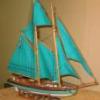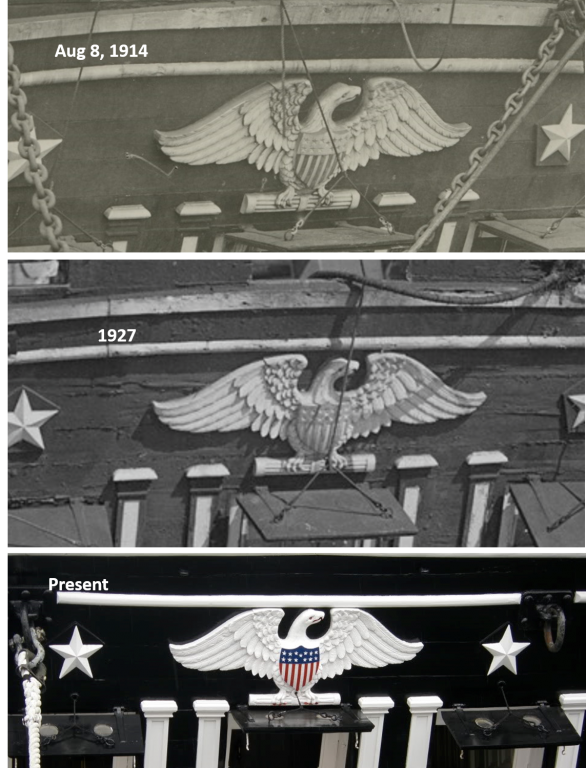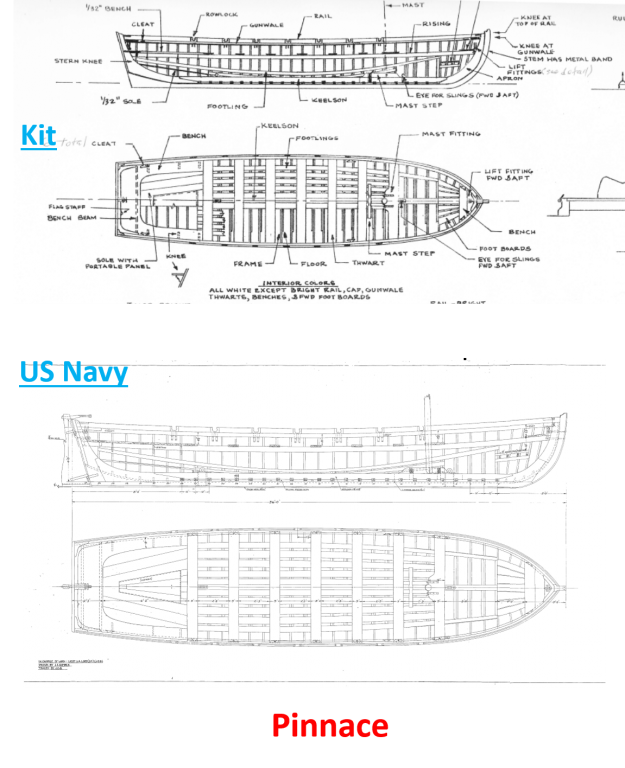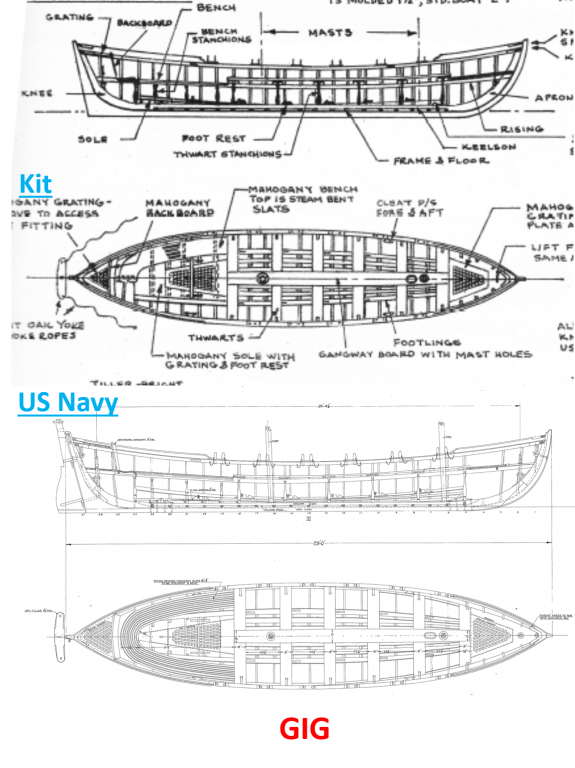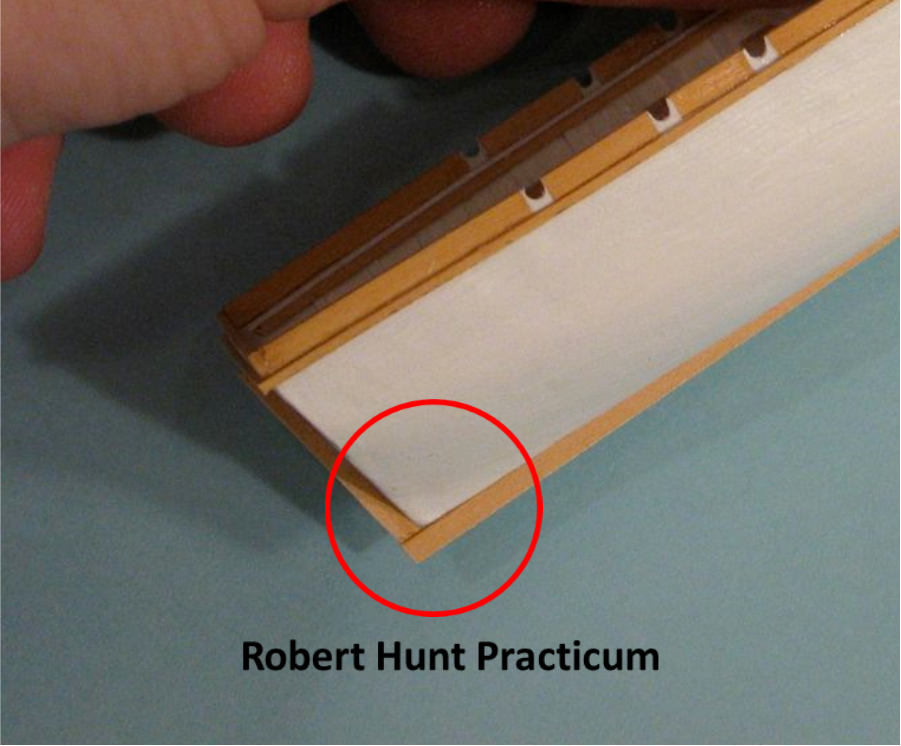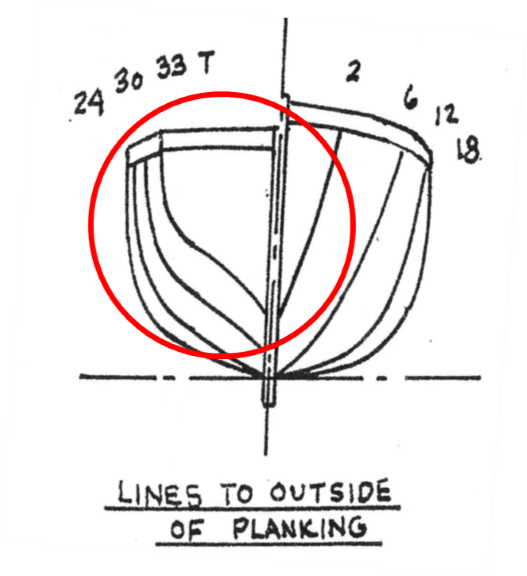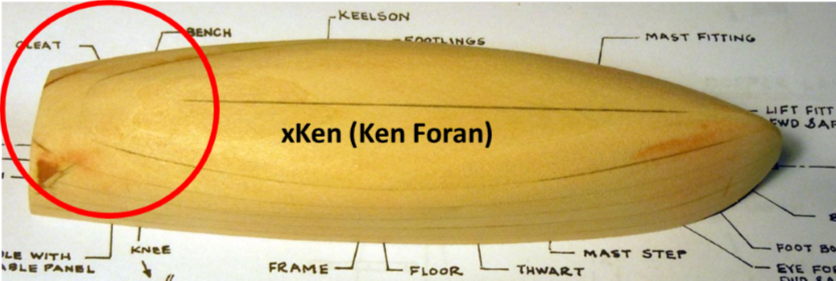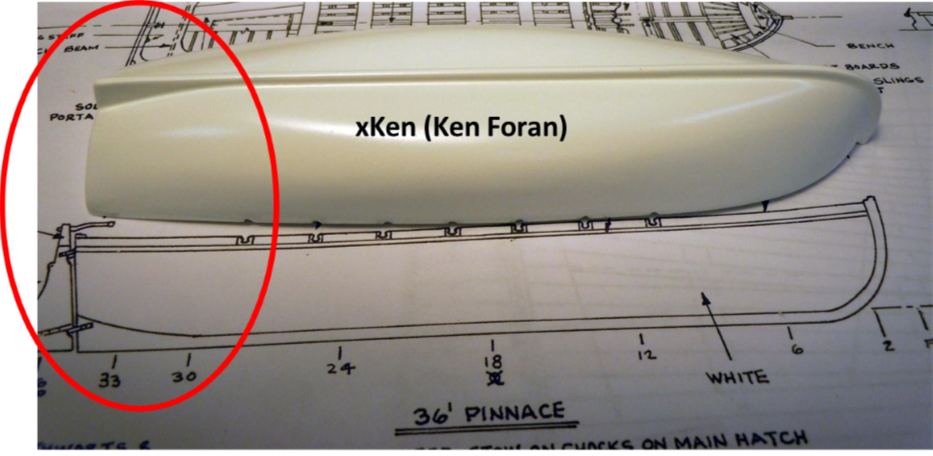-
Posts
2,611 -
Joined
-
Last visited
Content Type
Profiles
Forums
Gallery
Events
Everything posted by JSGerson
-
The two whaleboats progressed in the same manner as the gig. At this point, Model Expo came through and my paint package arrive...supposedly again. This time it did not disappear. A coat of white primer was applied to all four boats. I hadn’t realized that I didn’t coat evenly until I saw this photo, but a second coat of primary color paint should take care of that.
-
Are the furlough sails full size sails rolled up? Is that what you mean by "full size sails"? I thought most model builders "cheat" and use just enough material to make furlogh sails look realistic. The problem of course is the scale of the sail material; you just can't get something thin enough, with the right. texture, and translucency to match the scale. Jon
- 481 replies
-
- rattlesnake
- model shipways
-
(and 1 more)
Tagged with:
-
You should be very proud. Now I've got to ask a few questions: I assumed you carved the stars. How did you hold them to do it? The nameplate intrigued me: Did you carve the letters? If not, what did you use? How did you achieve the very thin white border around the nameplate? Jon
- 742 replies
-
- constitution
- frigate
-
(and 1 more)
Tagged with:
-
Do be careful when using the styrene. I've been told they yellow as they age so it's best to paint them.
- 742 replies
-
- constitution
- frigate
-
(and 1 more)
Tagged with:
-
- 742 replies
-
- constitution
- frigate
-
(and 1 more)
Tagged with:
-
Those are some nices blades. If only I was doing more carving on a regular bases I could justify those prices. I means they are like peanuts...you just aren't satisfied with only one. 8-)
- 742 replies
-
- constitution
- frigate
-
(and 1 more)
Tagged with:
-
I am curious about the tools you are using for the carving especially the spoon chisel (I think) in the X-acto type handle. Is that part of a set and where did you buy them? Jon
- 742 replies
-
- constitution
- frigate
-
(and 1 more)
Tagged with:
-
Gig Like the pinnace, the gig kit plans are very accurate as compared to the US Navy’s plans. Hunt’s practicum shows you how to make an acceptable looking model though not necessarily complete or accurate. Some points: The practicum uses one strip of styrene over the ribs to form the gig apron, keelson, and knee. Like the pinnace, I plan to use separate pieces for each and notch the keelson to fit over the ribs as shown on the plans The average observer may not see this detail, but I will know. A lot of the hardware and detail (e.g., lifting rings) were left off due to scale size, visibility, or complexity. The gig backboard and all the gratings were eliminated The gig thwart support stanchions were eliminated The oarlocks were eliminated The “wing” on top of the rudder, and the pintle and gudgeon were eliminated The slats for the stern benches are too fine for this scale and were rightfully replaced by a single sheet of wood. I have ideas about those and the gratings. My intent is to add as much of the detail shown on the plans to the model to the limits of my ability and patience. Here is the gig at the same point as the pinnace with the ribs and flooring supports waiting paint. The only difference is that I added the interior gunwale. So, onto the two whaleboats:
-
At this point I had intended to paint the pinnace before moving on. However due to some unknown circumstance, my order for the USS Constitution paint package which was ordered last month never arrived. Both Model Expo and the US Post Office have recorded the package as being delivered within a week of my order, but that was a month ago, and I never got them. Model Expo has promised to resend another shipment. Thus, I have moved on to the gig.
-
General Thoughts Having the actual plans from the US Navy for the ships boats is wonderful and luxurious. Usually when making a model I must rely totally on the kit to provide me with the all the details because I normally don’t have the real thing to look at. My Rattlesnake is an example. With the actual plans, I can see how the kit’s plans adjusted for scale and ease of building. With the build logs, I can also see what other builders added, modified, or eliminated.
-
In my last post, I had forgotten that I had taken some shots of the notched keelson (they were still in the camera) so here they are. BTY, you can see where the styrene broke. Luckily, all of this will be under a couple of coats of paint and nearly hidden once the boats are completed. So unless you know they are there and have very good eyesight with proper lighting, it will be hidden.
-
Not only do I not know when that plan was drawn, I don't know where I originally found. I thought I got from the CD the Constitution museum was selling, but it's not on there or on the 2001 version of the CD. At one time, the US Navy had a lot of their plans on their website, but no more. I must have gotten it there before they took down their archive pages. The only clue I have is the name G F Campbell written on the very bottom right hand corner of the document. The only G.F. Campbell I could find was the author of "China Tea Clipper" and "The Neophyte Shipmodeller`s Jackstay." Sorry I couldn't be more helpful Jon
- 1,348 replies
-
- constitution
- model shipways
-
(and 1 more)
Tagged with:
-
From the US Constitution CD of navy plans, see if this file helps on those bukwarks 10068001 - Gun Deck & Inside of Bulwarkse.pdf
- 1,348 replies
-
- constitution
- model shipways
-
(and 1 more)
Tagged with:
-
Thanks for the heat gun/hair dryer tip, Geoff. Looks like I might have to invest in one since I don't have either. My hair drys very quickly on it own so I don't use a dryer. Also, I'm a lifelong bachelor so I don't have any woman's paraphernalia lying around for my use (or abuse). I've heard that hair curlers can be used to bend wood for example. 8-) Jon
-
Thanks for looking in Don. No, I hadn't noticed. I haven't read the whole practicum, and as you have noticed, I jumped right to the last chapter to make the boats. I did notice that he made a lot of the parts out of styrene for example, the boat's apron,. I used boxwood. I'm going to try to stick to wood if I can. In the case of the boats ribs, it didn't make sense to struggle trying to bend the wood when it was going to be painted, so I used the styrene. I'll take it one step at a time to make those types of determinations. Thanks for the tip anyways. Jon
-
The practicum showed that Mr. Hunt had glued all the ribs in place and then glued the apron and knee on top of them. Both the MS plans and the US Navy plans show the apron and the knee glued directly to the shell with the ribs butting up them. This is what I did. Both plans show the keelson notched for the ribs and footings (which have yet to be installed) so it can be glued on top of the ribs and footings.
-
OK, back on course, if pardon the nautical reference. My styrene arrived and I proceeded to start the ribs. Having looked at several build logs, this didn’t appear to be too much trouble to do…riiiggghhht. I started by drawing a center line down the middle of the inside of the boat shell to ensure that when I glued the apron, keelson, and the stern knee, it would be properly positioned. Then I marked the position of the center rib. Using CA glue, I cemented the rib in place a bit at a time. I was using clothes pin clamps and I didn’t want those to get glue on them. When I was done, I saw that the rib had shifted a bit so it was not perpendicular to the center line. This was important because all the other ribs would be position off this rib using a spacer block; so it had to be right. When I tried to lift the rib from the shell with very little pressure with an X-acto blade, it snapped. The CA glue had made the flexible styrene brittle. So when gluing these ribs, they have got to right the first time. Another thing I noticed while reviewing other build logs where they have documented their ship’s boats construction, is that no two pinnaces were built the same even though MS provides a detailed plan based on the US Navy plans. I can understand when the actual ship and or plans no longer exists so the builder has a lot of room for interpertation. Well, I guess I will find out why as I progress through the construction of this beautiful little craft. Following the construction process of the practicum, I used a “spacer” to maintain the separation of the ribs as each one was glued into place.
-
Those ratlines look gorgeous! A few questions if I may: Are you using the line that came with the kit or an outside supplier (e.g., Syren). Also, are the sizes of stay and ratline lines as dictated by the kit's instructions or are you going by some other source? Details, alway love the details 8-) Jon
-
I'm always curious as to how everyone makes their ladders since they have been a bane for me. Yours caught my eye because I've never seen one done quite that way - notched in back. Now I don't want to be a critic, but the steps appear to be 90 degrees to the side rails. Since the ladder is being used at an angle, shouldn't the steps be at angle also so that they are level? Love your work by the way. Jon
- 108 replies
-
- mamoli
- constitution
-
(and 2 more)
Tagged with:
-
Moving on, I thought I would make the stem and keel parts while still waiting for the styrene strips. It was at this point that my good feeling sank a bit. Looking at the practicum, my pinnace shell looked very similar to what was shown. However, when I looked at the plans to make the templates for the keel and stem I found another problem. The aft end of the boat angled up. See the pictures below. I checked other build logs and those with images of the pinnace that showed the bottom of the boat, all agreed with the plans, not the practicum. So, I have a bit more carving to do. In case you haven’t noticed, I’m still a novice when it comes to reading ship lines on plans.
About us
Modelshipworld - Advancing Ship Modeling through Research
SSL Secured
Your security is important for us so this Website is SSL-Secured
NRG Mailing Address
Nautical Research Guild
237 South Lincoln Street
Westmont IL, 60559-1917
Model Ship World ® and the MSW logo are Registered Trademarks, and belong to the Nautical Research Guild (United States Patent and Trademark Office: No. 6,929,264 & No. 6,929,274, registered Dec. 20, 2022)
Helpful Links
About the NRG
If you enjoy building ship models that are historically accurate as well as beautiful, then The Nautical Research Guild (NRG) is just right for you.
The Guild is a non-profit educational organization whose mission is to “Advance Ship Modeling Through Research”. We provide support to our members in their efforts to raise the quality of their model ships.
The Nautical Research Guild has published our world-renowned quarterly magazine, The Nautical Research Journal, since 1955. The pages of the Journal are full of articles by accomplished ship modelers who show you how they create those exquisite details on their models, and by maritime historians who show you the correct details to build. The Journal is available in both print and digital editions. Go to the NRG web site (www.thenrg.org) to download a complimentary digital copy of the Journal. The NRG also publishes plan sets, books and compilations of back issues of the Journal and the former Ships in Scale and Model Ship Builder magazines.


